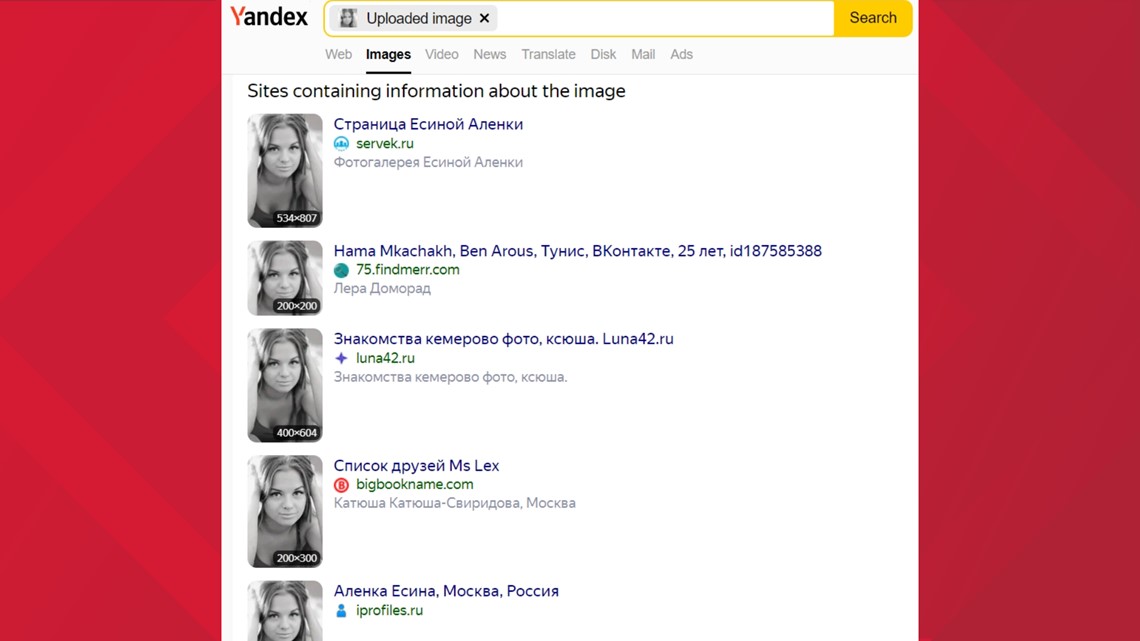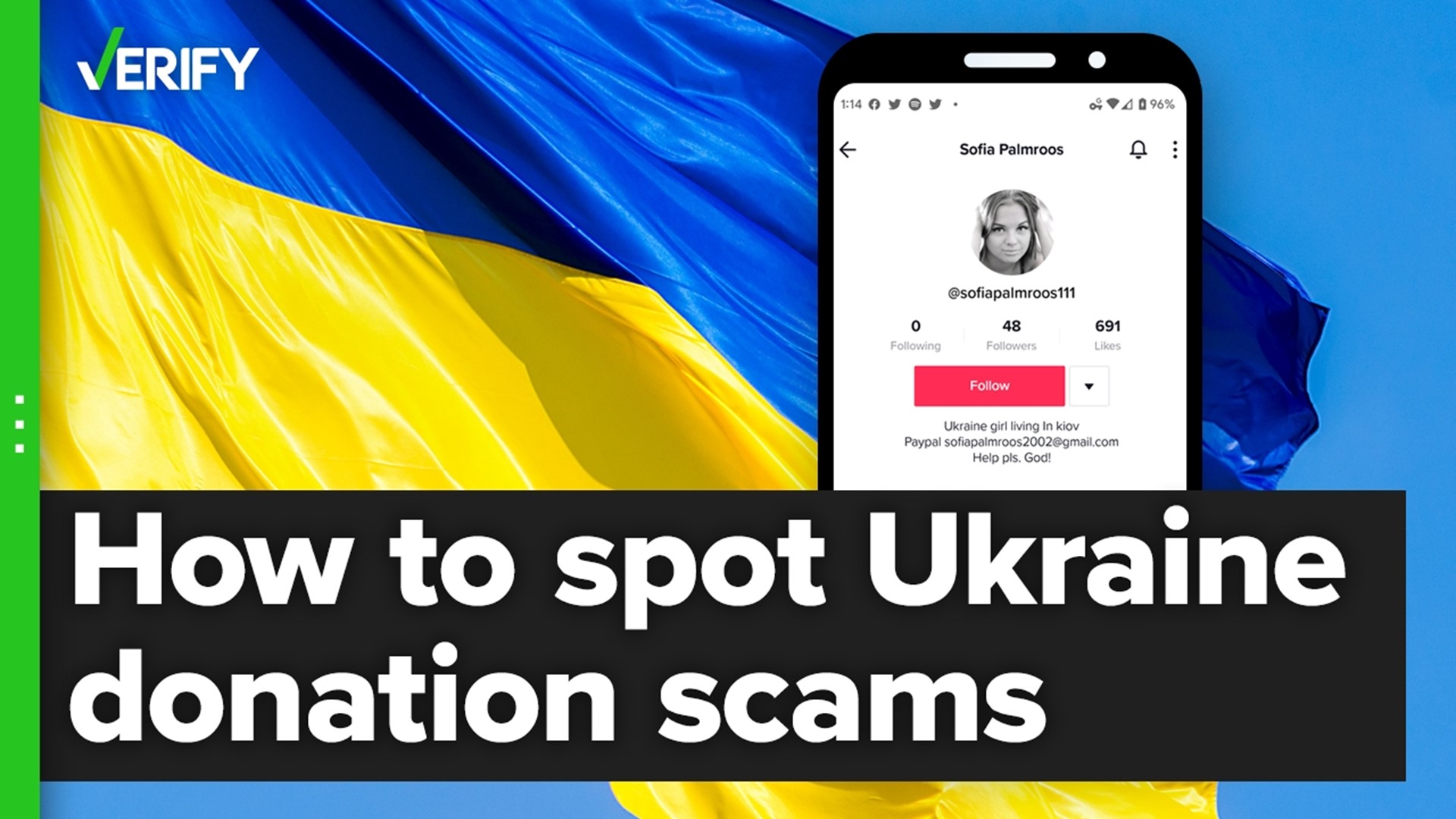Russian President Vladimir Putin launched a military invasion of Ukraine just before dawn on Feb. 24. Since then, TikTok has been full of videos and livestreams asking for donations for Ukraine.
In most of these videos, people ask viewers to donate to a charity, but some of the videos and livestreams are of people claiming to be from Ukraine asking for personal donations to help themselves or their families.
It can be difficult to know if a stranger asking for money over social media is who they say they are. We’ve put together some tips to help you figure out if an account is legit using one account soliciting for personal donations as an example.
The account, sofiapalmroos111, has posted two videos since Russia’s invasion of Ukraine began. One of those videos is tagged “#donateme” and the account itself lists a PayPal username in its bio, and claims to be a “Ukraine girl living In kiov [sic].”
Editor’s note: We have a list of some legitimate organizations soliciting donations at the end of this article.
THE SOURCES
Laurie Styron, executive director of CharityWatch
Monito, a comparison service for international money transfers
Laurie Styron, executive director of CharityWatch, says you should generally avoid donating to crowdfunding campaigns or individuals in most cases regarding a crisis like this.
“The only exception to that might be if you personally know someone in the region, or you have someone who can vouch for that person,” Styron said. “In that case, the crowdfunding site can be a very convenient, easy way to get resources to someone in the region. If you don't know the person, it's really not the best way to give — you're really kind of taking a big risk.”
If you still want to donate directly to individuals, you should at least take precautions to make it less likely you’re scammed. Here are six things to be on the lookout for when figuring out if an account is real:
1. Is the profile picture generic?
One of the first things you should do is a reverse image search of the account’s profile picture. You can do a reverse image search by saving an image, opening up Google Images or another search engine’s image search, clicking the “search by image” icon and uploading the image into the search bar.
If that search reveals the picture is actually another person’s profile photo or is a stock image, then it’s likely the person running the account isn’t who they say they are.
In the case of sofiapalmroos111, a reverse image search on Google doesn’t return any results. But that doesn’t necessarily mean the photo is unique. A reverse image search of the image on the Russian search engine Yandex reveals that the photo is used for profiles on a number of Russian social media websites, often alongside different names. None of those accounts use the name “Sofia Palmroos,” which is the name the TikTok account uses.


A common profile picture or a stock photo profile picture doesn’t necessarily mean an account isn’t from Ukraine, or that it’s fake. A real Ukrainian person might want to hide their identity for safety reasons, or this might be the one account that actually belongs to the person in the photo. But, in conjunction with other red flags, profile pictures can be the first indicator that a profile might be untrustworthy.
2. Is the account brand new?
An account’s age is easy to check and can suggest someone might simply be looking to take advantage of a real-world tragedy to benefit themselves. A newly created account immediately looking for donations from others upon its creation is far less credible than an account that has been around and posting videos long before seeking help from others.
The sofiapalmroos111 account, for example, never posted a video until after Russia’s invasion of Ukraine began. Once again, this alone doesn’t mean the owner of the account is from somewhere other than Ukraine; the account could belong to a Ukrainian person who didn’t use TikTok before, heard about the donation drives on the platform and created an account to seek out emergency funds. But, like a generic profile picture, the account’s age makes it more suspicious when considering the rest of these five tips.
As an additional tip, an older account might also have giveaways to its inauthenticity. If an account has a history of posting videos located somewhere other than Ukraine, and the account’s owner has never talked about being from Ukraine or visiting Ukraine, then it makes it less likely that the person is actually from Ukraine if they later seek out donations.
3. Do the videos posted to the account show real clips from Ukraine?
If a person isn’t actually in Ukraine, they won’t be able to record their own video of the invasion. One strategy such a person might use is to post video of other events in the place of real footage.
The first video posted by sofiapalmroos111 depicts an explosion near an apartment building, tagged “#war” and “#ukraine.” But a Yandex reverse image search of a screenshot from that video reveals that it’s an image-flipped video of a gas station explosion in Novosibirsk, Russia from 2021.
The video can be found on an Instagram post from June 15, 2021, with its location-tagged to Novosibirsk. Russian media, such as the Moscow Times and the state-run RIA Novosti news agency, reported that a fuel pump at a gas station within the city had exploded on June 14, 2021. Other angles of the same explosion can be found in a number of YouTube videos.
This video is particularly deceptive because it is of an incident that got little press coverage in mainstream English-speaking media. Most of the people who would have seen the video on TikTok would not have ever seen the original video before it was tagged as part of Russia’s attack on Ukraine.
4. Have the videos on the account been posted elsewhere by someone else before?
Another way a person from outside of Ukraine might pretend to be from the country is to take authentic videos from other accounts and post them like they recorded the video themselves. While a real Ukrainian person seeking help may post videos from other people, they are unlikely to pass it off as their own video.
The second video posted by sofiapalmroos111 is of a group of helicopters flying across the sky with the caption “Russian army attacking my country.” The video is really from Kyiv, Ukraine’s capital, but it’s not from Russia’s ongoing invasion.
That video was first posted online on Aug. 19, 2021, by a Russian-speaking person on Facebook who said the video was of helicopters over Kyiv. At that time, Ukraine’s military was participating in daily rehearsals for a parade to celebrate the 30th anniversary of Ukraine’s independence scheduled for Aug. 24, 2021. Photos and news coverage of the final week of rehearsals could be found in the Kyiv Post, the American government-run Radio Free Europe and the Pacific Press Agency.
While this video is of something that occurred months before Russia’s invasion, it’s equally possible for fake accounts to take a video someone else posted the day before, or even earlier that day, and pass it off as their own. If you think you may have seen the video before, it’s a good idea to see if you might be able to find it again.
5. Does the account make spelling mistakes it shouldn’t make?
English isn’t the first language of a person from Ukraine, so an account isn’t suspicious just because it makes spelling mistakes or has poor grammar. But some spelling mistakes put an account’s credibility more in question than others.
The bio for the sofiapalmroos111 account states that the account owner is from “Kiov” instead of “Kyiv.” That mistake stands out because based on the Ukraine government’s official transliteration of the Ukrainian alphabet to the Roman alphabet used for English, Ukraine’s capital city, Київ, should be spelled “Kyiv.”
6. Does the account ask for donations through PayPal or Venmo? Does PayPal work in Ukraine? What about Venmo?
Be wary of accounts asking for money through PayPal or Venmo. The only PayPal feature available to Ukrainians is the ability to send or spend money. Ukrainians on PayPal cannot receive money from others.
Individuals have different money transfer options than businesses, but Monito, a comparison service for international money transfers, lists Wise, Paysend, MoneyGram and other services as ways Americans can send money to Ukraine.
Monito explains that individuals can’t use Venmo to send money to Ukraine, either. Venmo requires both users in a transaction to have a U.S. bank account, restricting its use internationally.
What are some credible places to donate to?
The official Twitter account of the Ukraine government posted a pair of donation links for helping Ukraine’s military. The first is for a National Bank of Ukraine fund to support the country’s armed forces, and the second is a link to a fund for the charity Come Back Alive, which provides support for soldiers involved in the war.
The National Bank of Ukraine only takes donations through card payments, while the Come Back Alive fund accepts both card payments and Bitcoin payments.
The Red Cross is also active in Ukraine and has shared its own donation links for supporting its work in Ukraine.
Laurie Styron, executive director of CharityWatch, says charity organizations are typically better to donate to than crowdfunding campaigns or individuals because they make sure no one person gets all of the aid for themselves.
“Nonprofit organizations are just much better equipped to make sure that when you donate, those resources are distributed equitably to the people and to the needs that are the most important for emergency aid in that moment,” Styron said.
More from VERIFY: Fact-checking videos claiming to show Russia’s aerial attacks on Ukraine

